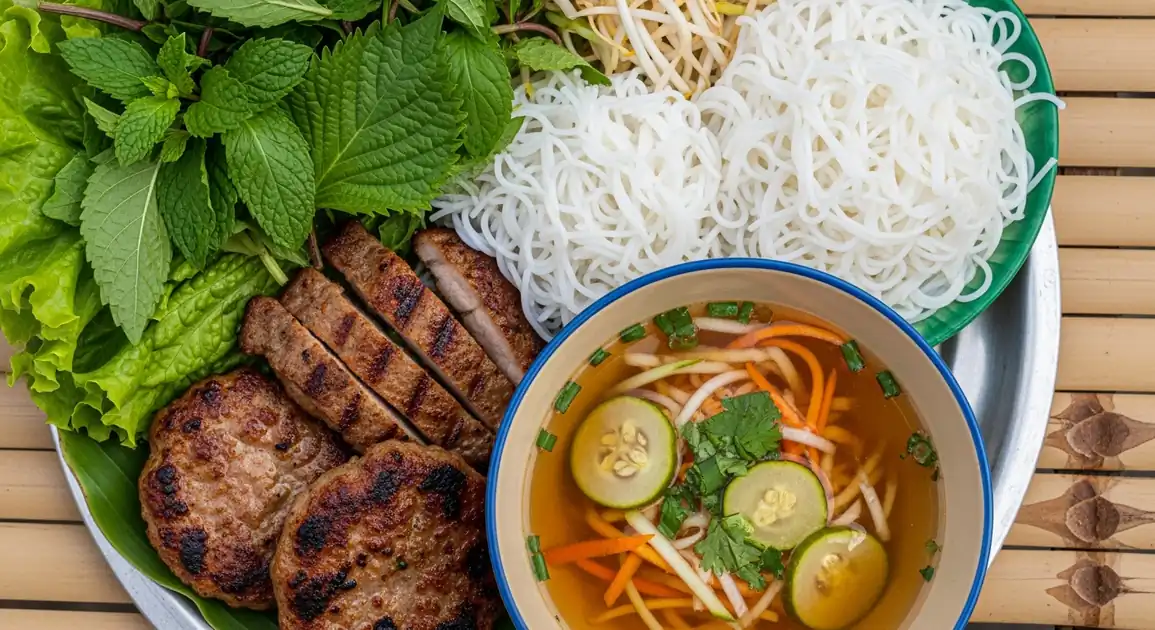Bun Cha
Bún Chả

Description
Bun Cha is primarily a northern Vietnamese dish, with Hanoi being its epicenter. While you can find it throughout the country, the authentic experience is in the capital city where small specialized eateries have been perfecting this dish for generations. In central and southern Vietnam, similar dishes like Bun Thit Nuong are more common, though tourist areas will often offer Bun Cha to satisfy visitors seeking this iconic dish.
Dietary Information
Serving information
Serving style
Traditionally served as a set with separate components: a bowl of dipping sauce with grilled meat and pickled vegetables, a plate of rice vermicelli noodles, and a basket of fresh herbs and lettuce. Diners combine these elements in their own small bowls.
Quick facts
Most Bun Cha vendors operate from roughly 10 AM - 2 PM, with peak hours between 11 AM - 1 PM. Many close once they've sold out.
Safety Tips
What to Look For
-
Active charcoal grilling with visible smoke and aroma
Freshly grilled meat ensures proper cooking temperatures and minimizes time in the temperature danger zone. The smoke and aroma indicate authentic preparation method.
-
Clear, amber-colored dipping sauce/broth
Quality dipping sauce should be transparent amber-brown, not cloudy or murky, with visible slices of pickled vegetables. Cloudiness can indicate poor preparation or contamination.
-
Crisp, vibrant fresh herbs without wilting or discoloration
Fresh herbs are essential for both flavor and safety. Properly handled herbs should look recently harvested with no browning or sliminess.
-
Busy establishment with high customer turnover
Popular spots mean ingredients are replenished frequently and food doesn't sit around long. Local customers often know the best and safest options.
What to avoid
-
Pre-grilled meat sitting at room temperature
Meat should be grilled to order or at least kept over heat. Avoid places where meat patties are stacked and stored at ambient temperature for extended periods.
-
Cloudy, overly sweet, or off-smelling dipping sauce
The nước chấm should have a balanced smell without excessive fermentation odor. Cloudy sauce may indicate poor preparation or storage conditions.
-
Wilted, yellowing, or slimy herbs
Poor-quality herbs suggest general inattention to freshness and could indicate other ingredients are also past their prime.
-
Cross-contamination between raw and cooked meat
Watch how vendors handle meat. Avoid places where the same utensils or surfaces are used for raw and cooked pork without cleaning.
Price information
Price range
Budget tips
- Local street vendors typically charge 35,000-60,000 VND per portion.
- More touristy establishments may charge up to 100,000 VND.
- A 'nem cua be' addition (crab spring rolls) will increase the price by roughly 15,000-30,000 VND.
- Prices are typically higher in tourist districts like Hoan Kiem in Hanoi.
Value indicators
- Generous portion of well-caramelized, freshly grilled meat.
- Ample serving of fresh herbs with multiple varieties.
- Clear, flavorful dipping sauce with balanced sweet-sour-savory notes.
- Inclusion of nem cua be (crab spring rolls) at reasonable additional cost.
Where to Find This Dish
Old Quarter
Hanoi's historic district contains many famous Bun Cha establishments, particularly along the smaller alleys.
Dong Xuan Market, Hoan Kiem Lake, St. Joseph's Cathedral
11 AM - 1 PM
Ba Dinh
The area around the Ho Chi Minh Mausoleum and Presidential Palace has several well-established vendors.
Ho Chi Minh Mausoleum, Temple of Literature, Truc Bach Lake
11:30 AM - 1:30 PM
Vendor Tips
- Many of the best Bun Cha places close once they run out of food, often by 2 PM.
- Look for places displaying the meat being actively grilled rather than pre-cooked meat sitting in trays.
- Some vendors might add fresh sliced chili directly to your dipping sauce – request 'không ớt' (no chili) if you prefer milder flavor.
How to Order
Regional Variations
-
Classic Hanoi-Style Bun Cha
(Bún Chả Hà Nội)
The traditional version featuring both chả (grilled patties) and thịt nướng (grilled belly slices) served in a room-temperature dipping sauce with rice noodles and herbs on the side.
-
Bun Cha with Crab Spring Rolls
(Bún Chả Nem Cua Bể)
The classic dish accompanied by fried spring rolls filled with crab meat, which are typically dipped in the same sauce as the grilled pork.
-
Bun Cha in Bowl
(Bún Chả Bát)
A serving variation where components are combined in a larger bowl rather than the traditional separate plates and dipping sauce.
-
Countryside-Style Bun Cha
(Bún Chả Quê)
A rustic version often featuring thicker-cut pork and more pronounced lemongrass and galangal flavors in the marinade.
Cultural context
History
Originating in Hanoi, Bun Cha has been a staple of northern Vietnamese cuisine for generations, though its exact origins are unclear. Traditionally a lunch dish eaten by workers, it gained international recognition when Anthony Bourdain took President Barack Obama to Bun Cha Huong Lien in 2016. The restaurant subsequently created the 'Obama Combo' memorializing their order. Historically prepared by charcoal grilling over clay braziers on sidewalks, the dish exemplifies Hanoi's straightforward yet sophisticated street food tradition that emphasizes balanced flavors and quality ingredients over complexity.
Local significance
Bun Cha is a culinary cornerstone of Hanoi identity, with locals fiercely loyal to their favorite vendors. It represents the subtle, balanced approach to flavors that characterizes northern Vietnamese cuisine, in contrast to the bolder, spicier dishes of central and southern regions.
Eating customs
- Lean slightly forward while eating to avoid dripping sauce on clothing.
- It's acceptable to lift your bowl closer to your mouth while eating.
- Combine small portions of each component rather than mixing everything at once.
- If crab spring rolls (nem cua be) are ordered, they're typically dipped in the same sauce as the pork.